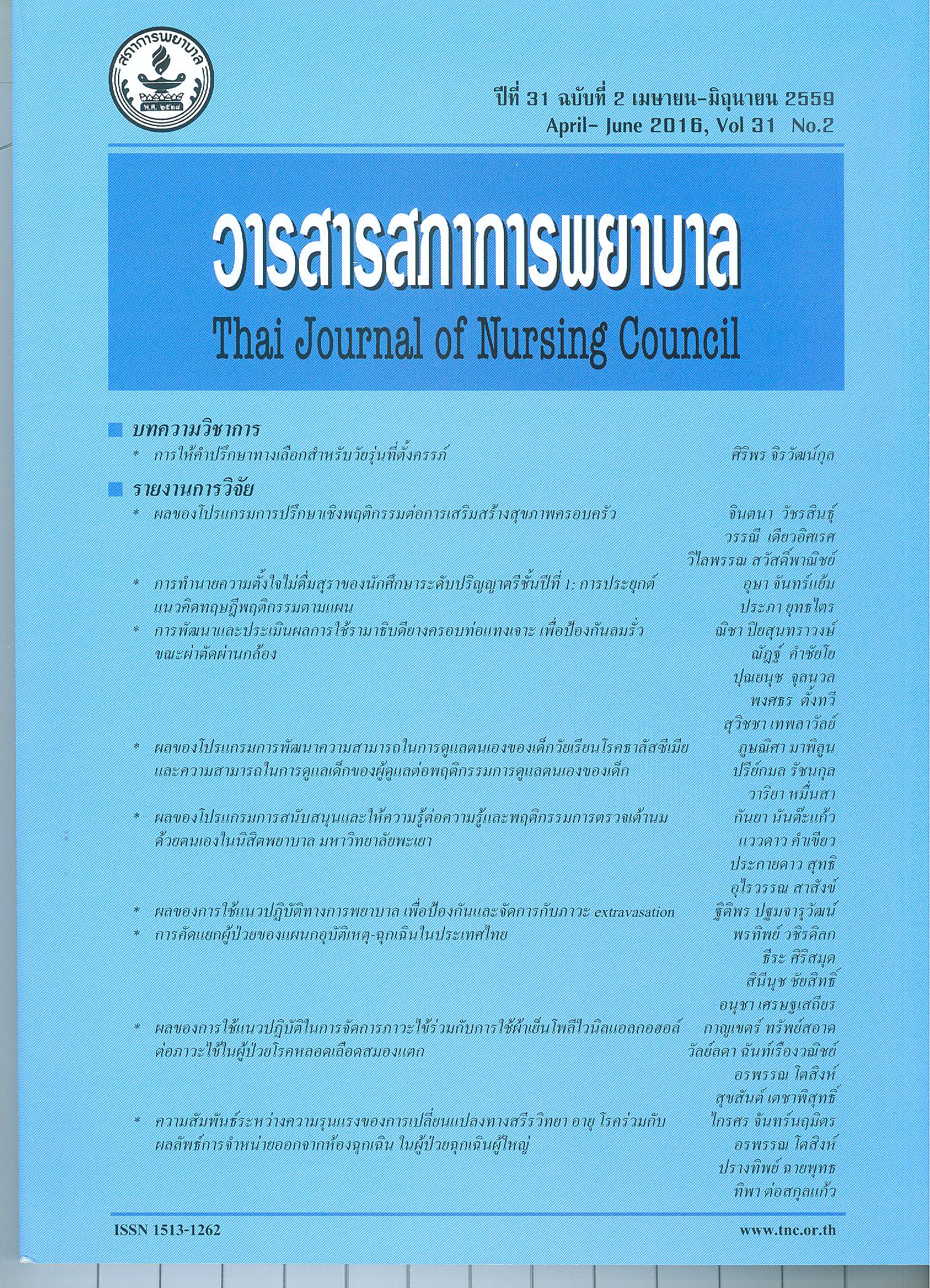ผลของการใช้แนวปฏิบัติทางการพยาบาลเพื่อป้องกันและจัดการกับภาวะ extravasation
Keywords:
แนวปฏิบัติทางการพยาบาล, ผู้ป่วยที่ได้รับสารน้ำทางหลอดเลือดดำ, ภาวะ extravasation การป้องกันและจัดการ, nursing care guideline, patients receiving intravenous infusion, prevention and management of extravasationAbstract
วัตถุประสงค์การวิจัย: เพื่อศึกษาผลของการใช้แนวปฏิบัติทางการพยาบาลเพื่อป้องกันและจัดการกับการเกิดภาวะ extravasation ในผู้ป่วยที่ได้รับยาหรือสารน้ำทางหลอดเลือดดำที่มีความเสี่ยงต่อการเกิดภาวะ extravasation
การออกแบบวิจัย: การวิจัยกึ่งทดลองแบบสองกลุ่มวัดก่อนและหลัง
การดำเนินการวิจัย: กลุ่มตัวอย่างเป็นผู้ป่วยที่ได้รับยาหรือสารน้ำทางหลอดเลือดดำที่มีความเสี่ยงต่อการเกิดภาวะ extravasationที่ได้รับการรักษาในโรงพยาบาลตติยภูมิแห่งหนึ่ง จำนวน 50 ราย แบ่งออกเป็น 2 กลุ่ม โดย 25 รายแรกเป็นกลุ่มควบคุมที่ได้รับการพยาบาลตามมาตรฐานของหน่วยงาน และ 25 รายหลังเป็นกลุ่มทดลองที่ได้รับการพยาบาลตามแนวปฏิบัติทางการพยาบาลเพื่อป้องกันและจัดการกับการเกิดภาวะ extravasation เครื่องมือที่ใช้ในการเก็บรวบรวมข้อมูล ได้แก่ แบบบันทึกข้อมูลส่วนบุคคล แบบประเมินการเกิดภาวะ extravasation และแบบบันทึกติดตามการฟื้นหายของแผล วิเคราะห์ข้อมูลโดยใช้สถิติไคสแควร์และสถิติ ทดสอบทีแบบอิสระ (independent t-test)
ผลการวิจัย: กลุ่มทดลองที่ได้รับการพยาบาลตามแนวปฏิบัติฯมีอุบัติการณ์การเกิดภาวะ extravasation และระดับความรุนแรงของการเกิดภาวะ extravasation ต่ำกว่ากลุ่มควบคุมอย่างมีนัยสำคัญทางสถิติ (p<.001) และค่าเฉลี่ยระยะเวลาฟื้นหายของแผลเร็วกว่ากลุ่มควบคุมอย่างมีนัยสำคัญทางสถิติ (p =.001)
ข้อเสนอแนะ: ควรนำแนวปฏิบัติทางการพยาบาลฯนี้ไปใช้ในผู้ป่วยที่ได้รับยาทางหลอดเลือดดำเพื่อป้องกันและจัดการกับภาวะ extravasation
Objective: To study the use of the nursing care guideline for extravasation prevention and management in extravasation-risk intravenously infusion patients.
Design: Two-group experimental research, with a pre-test and a post-test.
Implementation: The sample for this study consisted of 50 extravasation-risk intravenously infusion patients being treated at a tertiary hospital. Twenty-five of the patients were put in a control group and the others in an experimental group. Whilst the control group was given the hospital-required standard care, the experimental group received the nursing care method designed for extravasation prevention and management. The data collection instruments were (1) a personal information form; (2) an extravasation assessment form; and (3) a wound recovery monitoring form. The data were analysed using chi-square statistics and a bivariate independent t-test.
Results: Compared with the control group, the experimental group displayed a significantly lower degree of extravasation occurrence and severity (p < .001). Similarly, the experimental group’s average wound recovery time was significantly shorter than that of the control group (p = .001).
Recommendations: This nursing care guideline should be applied to the intravenous infusion process to help prevent or manage extravasation.
Downloads
References
Doellman D, Hadaway L, Bowe-Geddes LA, et al.Infiltration and extravasation: update on prevention and management. J InfusNurs 2009; 32(4):203-11.
Dougherty L&Lister S.The Royal Marsden Hospital Manual of Clinical Nursing Procedures. 8 thed. Oxford: Wiley Blackwell; 2011.
RCN. Standard for Infusion therapy. London: RCN; 2010.
INS. Infusion Nursing strandard of practice. J Infus Nurs 2011; s65-72.
Al-Benna S, Boyle C, Holley J. Extravasation Injuries in Adults. ISRN Dermatology 2013; 8-16.
Hadaway LC. Emergency: infiltration and extravasation-preventing a complication of I.V. catheterization. Am J Nurs 2007; 107(8):64-72.
Kumar RK, Pegg SP, & Kimber RM. Management of Extravasation Injuries. ANZ J. Surg 2001; 71:285–9.
Hadaway LC. Infiltration and extravasation. Am J Nurs 2007; 107(8):64-72.
James RR. Epinephrine in the ED: Extravasation of Vasopressors. EM News 2005; 27(5): 31-34.
Sauerland C, Engelking C, Wickham R, Corbi D. Vesicant extravasation part I: Mechanisms, pathogenesis, and nursing care to reduce risk. OncolNurs Forum 2006; 33(6):1134-41.
Ruangtrakool R. Quality Conference No.5/2557. Available from: http://www1.si.mahidol .ac.th/km/sites/default/files/u11/QualityConference%205_2557.pdf. Accessed October 12, 2015. (in Thai)
Pathomjaruwat T. Development Efficacy of Nurse in IV administration on effectiveness and safety care in Medical Intensive Care Unit, TU hospital. Project Development of Thammasat University Hospital No.6 /2556. Fair Hospital Quality. Title: Balance in Quality Life. Available from:http://www.hospital.tu.ac.th/PlanTUHosWeb/data/Project%20CQI/CQI_2556/56_047.pdf. Accessed August 28, 2015. (in Thai)
Hadaway LC. Preventing and managing peripheral extravasation. Nursing 2009; 39(10):26-7.
Robert JR. Epinephrine in the ED: Extravasation of Vasopressors. EM News 2005; 5(27):31-4.
Culverwell E. Pheripheral Intravenous Cannulation Self Learning Package. Intravenous Cannulation Handbook 2010. Canterbury District Health Board; 2010.
Burns N & Grove SK. Appraisal synthesis and generation of evidence. The practice of nursing research. 6th ed. Philadelphia: W.B. saunders; 2009.
Soukup SM. The center for advance nursing practice evidence based practice model. Nurs Clin North Am 2000; 35(2):301-9.
Tilokskulchai F. Evidence-based Nursing: Principle and Method. 6th ed. Bangkok: Pre one; 2011. (in Thai)
Wengstrom Y, Foubert J, Margulies A, Roe H,Bugeia S. Extravasation guidelines 2007. Guideline Implementation Toolkit 2007. Available from: http://www.cancernurse.eu/ documents/EONSClinicalGuidelinesSection6-en.pdf. Accessed August 20, 2015
Warnock C. & Hall K. Extravasation Guidelines. North Trent Cancer Network. Approved: Chemotherapy Strategy Group 2011; 12(7):1-27.
Workman B. Peripheral intravenous therapy management. Emergency Nurse 2000; 7(9):31-9.
Schulmeister L. Managing vesicant extravasations. The Oncologist 2008;13:284–8.
Nahas VL, Chang A, Molassiotis A. Evidence Based Practice Guidelines for Managing Peripheral Intravascular access devices. JONA 2001. 31(4):164
Wilkinson R. Nurses' concerns about IV therapy and devices. Nursing Standard 1996; 10 (35):35-7.








